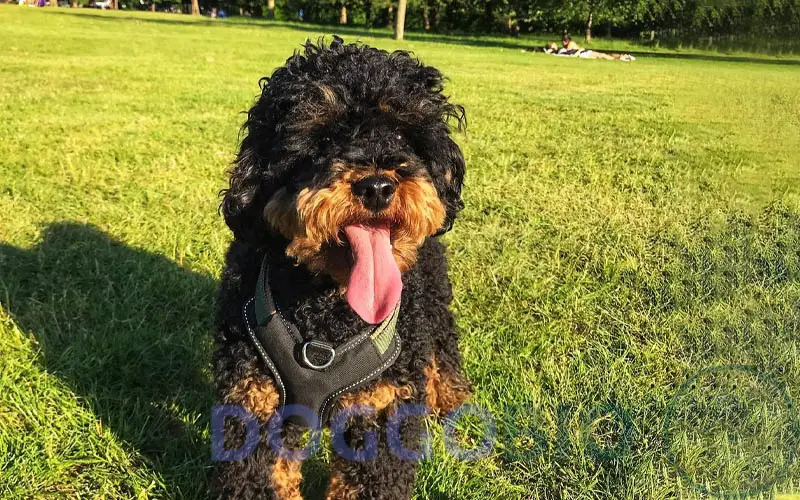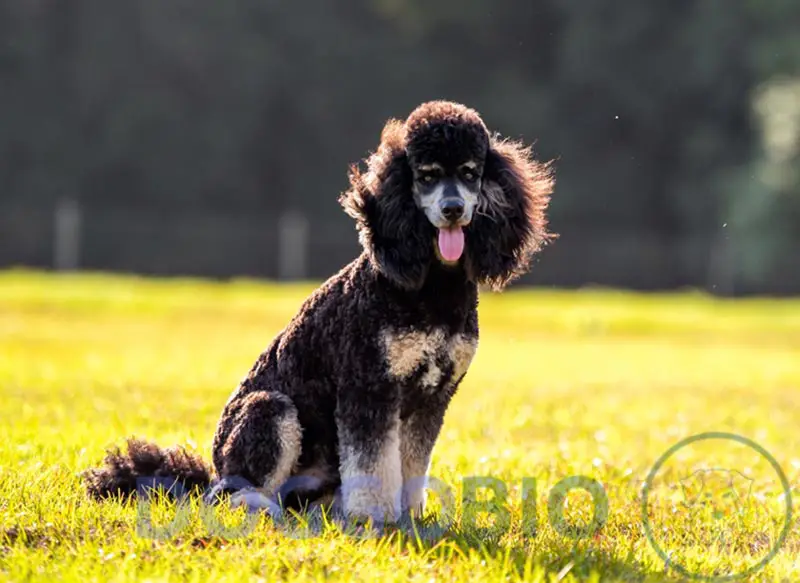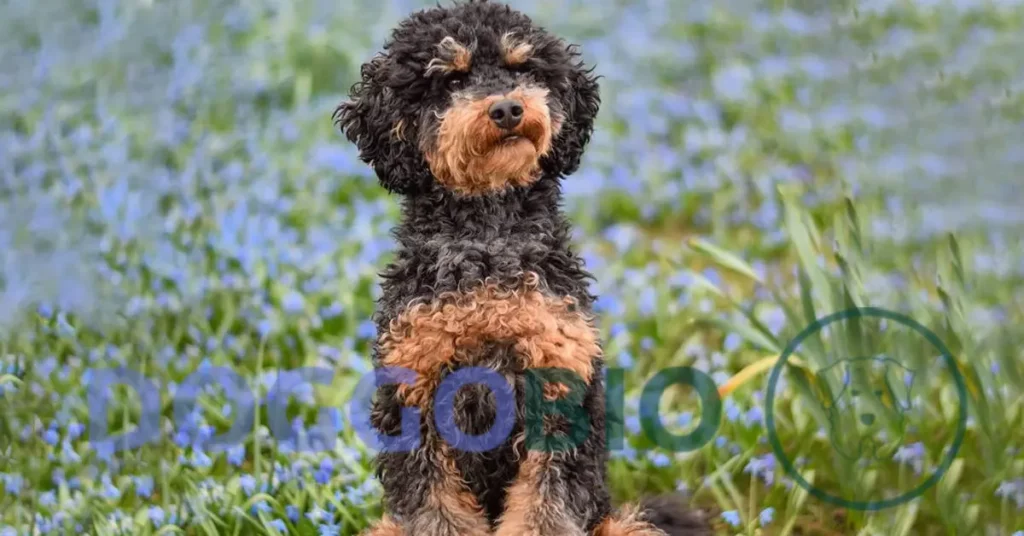The Phantom Poodle is a unique and striking dog breed known for its distinctive coat pattern. This breed is a variation of the Standard Poodle, but with distinct markings that give it a mysterious and almost ghostly appearance.
The Phantom Poodle is not only known for its stunning coat but also for its intelligence, loyalty, and playful nature.
In this article, we will explore the history, characteristics, and temperament, as well as tips for caring for and training this fascinating breed. Whether you are a seasoned dog owner or considering adding a new furry friend to your family, learning about the Phantom Poodle will surely be an enlightening and enjoyable experience.
A Brief Overview of Phantom Poodle
| Purity | Hybrid |
| Purpose | Companion dog |
| AKC Recognition | No |
| Size | Small – Large |
| Weight Range | 4 – 50 pounds |
| Height Range | 5 – 24 inches |
| Coat Colors | Black, Brown, Red, Silver, Apricot, Gray, Cream |
| Lifespan | 10 – 13 years |
| Average Puppy Costs | $2,000 – $3,000 |
What is a Phantom Poodle?

The Phantom Poodle isn’t a mythical dog but a Poodle with a distinct two-toned coat. While Poodles come in solid and multicolored variations, the Phantom falls under the latter. Its coat features a solid base with contrasting patches, creating a captivating look.
Contrary to some beliefs, Phantom Poodles are purebred. Historically, Poodles were multicolored, but breeders later favored solid hues. Thus, the Phantom Poodle is a vibrant nod to the breed’s colorful past.
Origins and History of Phantom Poodle
Many mistakenly believe Poodles hail from France, but in reality, these dogs first appeared in Germany as guidelines, named after their habit of emerging from the water dripping wet. These hunting dogs were adept at retrieving waterfowl from lakes and marshes, and as such, their coats were shaved strategically to protect them from the cold and avoid snagging underwater.
Poodles’ unique grooming style stems from their aquatic background as well. Their distinctive topknot with its colorful bow was once a practical way to locate and identify the dog while in the water.
As Poodles made their way to other parts of Europe, including France and England, they found a new niche as truffle hunters, often working with Dachshunds to find the prized delicacies.
While Parti Poodles appear in artwork from centuries past, Phantom Poodles were less frequently depicted, thanks to their recessive genetic trait that can remain hidden for generations. Nonetheless, these clever and amusing dogs are equally integral to the Poodle family tree as their solid-colored brethren.
What makes a dog a Phantom?
Phantom coloration in dogs is due to a mix of three genes, specifically the ky/ky genotype, E, and At. Without this combination, a dog cannot be considered a Phantom.
What does a Phantom Poodle Look Like?

Phantom Poodles stand out with their unique two-toned fur pattern. Unlike standard Poodles, they have a primary coat color with specific secondary color patches. These patches appear above the eyes, on the muzzle, chest, legs, and beneath the tail, often likened to Doberman markings.
While some breeds have fixed color combinations, Phantom Poodles come in a variety: black, chocolate, red, and silver. For instance, a black Phantom might have apricot, brown, cream, or silver markings. These distinct colors are a recessive trait, making them rarer in photos compared to other Poodle types.
Size, height, and weight
Phantom color Poodles come in all sizes, from standard and miniature to toy. However, some Poodle sizes have evolved to receive unique, unofficial classifications.
Interestingly, size does not necessarily correspond to weight or height, as Poodles of the same size may vary significantly. Therefore, it is crucial to determine the appropriate weight and height range for your Poodle based on its size and individual characteristics.
| Size | Height (Male/ Female) | Weight (Male) | Weight (Female) |
| Standard | 18-24 inches | 60-70 pounds | 40-50 pounds |
| Medium | 14-18 inches | 25-40 pounds | 20-35 pounds |
| Miniature | 11-14 inches | 10-15 pounds | 10-15 pounds |
| Toy | 9-11 inches | 9-11 inches | 9-11 inches |
| Teacup | 5-9 inches | 4-6 pounds | 4-6 pounds |
Temperament and Personality
While all Poodles are known for their sharp intellect and graceful demeanor, Phantom and Parti Poodles possess an extra dose of charm, wit, and intelligence that makes them stand out.
Indeed, these dogs are known for their athleticism and trainability, excelling in obedience, agility, and tracking events. They are also full of energy and love to play, making them great companions for active families.
But what sets Phantom Poodles apart from other Poodles is their unique character. Enthusiasts argue that these dogs possess a certain je ne sais quoi that makes them slightly more clever, amusing, and intelligent than their solid-colored counterparts.
Perhaps it’s their distinctive coloring that imbues them with an extra dose of personality, or it’s simply the fact that they are such a rare and unique breed. Whatever the reason, one thing is sure: if you’re looking for an elegant and entertaining dog, you can’t go wrong with a Phantom or Parti Poodle.
Is Phantom Poodle a good fit for families?
Undoubtedly, Phantom Poodles make for a fantastic family pet. They are renowned for their friendly and sociable nature, which makes them perfect for homes with children and other animals.
However, it is essential to note that early socialization is critical in how they interact with other pets and people. They can become your family’s loyal and affectionate companions with proper training and exposure.
Training

Training is intriguing as these puppies are surprisingly intelligent, making them highly trainable. These Poodles exhibit an unwavering willingness to please their owners, which makes the training process a breeze. Positive reinforcement keeps these pups motivated and focused on following your commands.
Exercise Requirements
Phantom Poodles are a breed that requires daily exercise to stay healthy and fit. This means they must be taken for a walk, run, or some other form of physical activity for at least 30 minutes to an hour daily. However, the amount of exercise needed may vary depending on the size of the Poodle.
Living Condition
Phantom Poodles thrive in indoor environments and flourish when given ample opportunities for social interaction with their owners. Natural hunters require a backyard where they can explore, play, and exercise freely. Ensure your backyard is well-fenced to prevent your puppy from wandering the streets.
Grooming and Cleaning
Oh my, grooming and cleaning your Phantom Poodle can be challenging! But fear not, for we have some tips to make your life easier.
1. Brushing
You’ll need to do this frequently using a slicker or a pin brush to avoid matting. The more often you brush your puppy, the silkier and shinier their coat will be. You can finish brushing with a metal comb to remove any leftover matting.
2. Bathing
It would help if you only did this once a month to prevent their skin and coat from drying out. Be sure to use a dog-specific shampoo that won’t dull their jacket. In between baths, you can use doggie wipes to clean them up.
3. Nail trimming
If you hear their nails clicking on the floor, it’s time to trim them down. Use a clipper or a dog nail grinder, but be careful not to cut them quickly. Overgrown nails can lead to skin infections, so pay attention to this task.
4. Brush their teeth
Phantom Poodles are prone to periodontal diseases, so they brush their teeth at least three times a week using enzymatic dog toothpaste. This helps break down bacteria and prevent tartar buildup and tooth decay.
5. Eye and ear care
Use a damp cotton ball to gently remove eye boogers to prevent eye irritations and infections. For ears, use gentle wipes or apply a few drops of dog-specific ear drops to remove wax and debris without drying out their skin.
| Grooming Needs | Grooming Frequency |
| Brushing | 3x per week |
| Bathing | Once a month |
| Nail Trimming | As needed |
| Teeth Brushing | 3 to 4x per week |
| Eye Care | Check weekly |
| Ear Care | Check weekly |
Are Phantom Poodles Hypoallergenic?
Yes, Phantom Poodles are hypoallergenic. Despite producing dander, Phantom Poodles are deemed hypoallergenic due to their low-shedding coat. This results in fewer allergens in the environment.
Additionally, they rarely drool, reducing saliva-related allergens. For those with dog allergies, a Phantom Poodle could be an ideal pet.
Food and Diet
Phantom Poodles require a diet jam-packed with protein, like beef, turkey, and chicken. It’s also important to include fats in their diet, as they are crucial for healthy growth and maintaining a healthy body.
Regarding how much to feed your dog, a standard-sized pooch should consume roughly 2 cups of food per day, whereas miniature Poodles should have around 1 cup per day, and toy Poodles should have about ½ cup per day.
Common Health Issues

1. Eyes Problem
Progressive Retinal Atrophy. This thing messes with your puppy’s retina, and it can cause them to lose their vision entirely. The deal with Progressive Retinal Atrophy is that it makes the cells in the retina start to break down, which can lead to all sorts of problems, like impaired night vision, blurred eyesight, and even blindness.
2. Hip Dysplasia
Hip Dysplasia is a hereditary disease that can cause the thigh bone to dislocate from its hip socket, causing excruciating pain and discomfort to your furry companion. Symptoms of this condition can manifest as early as five months old and make it difficult for the dog to move, jump or run.
3.Gastric dilatation-volvulus
Bloat, also known as gastric dilatation-volvulus, is a life-threatening condition that can be deceivingly simple. This condition occurs when the stomach distends, obstructing the passage of gas and food. It’s important to note that bloat can quickly escalate into a dire situation, so early recognition of the symptoms is vital.
4. Addison’s Disease
Addison’s Disease, a medical condition that affects Phantom Poodles, can be quite a nightmare. This condition arises when the adrenal glands do not produce enough cortisol, a hormone that controls various vital processes such as stress response, weight control, and fighting off infections.
When a Phantom Poodle suffers from Addison’s Disease, they may become lethargic and experience vomiting and digestive issues, among other things. In other words, this condition is a menace to your puppy’s overall health and well-being!
5. Hypothyroidism
This happens when a dog’s thyroid glands don’t produce enough hormones responsible for controlling metabolism. A puppy with this condition may experience hair loss, a dull coat, excessive hunger, and a weakened immune system.
6. Epilepsy
Epilepsy, a condition characterized by recurrent seizures, is not exclusive to humans but also afflicts Phantom Poodles.
How Long Do Phantom Poodles Live?
The good news is that Phantom Poodles have a similar lifespan to other Poodle types. Still, it’s worth noting that the Standard Poodle has a slightly shorter life expectancy than its Miniature or Toy counterparts.
If you’re the lucky owner of a Toy Phantom Poodle, you can expect your furry friend to stick around for approximately 14.5 years. For Miniature, the lifespan is a bit shorter, averaging around 14 years. And for those who adore Standard, you’ll have less time to spend with your furry friend, with an average lifespan of 12 years. Let’s not focus on the numbers; instead, cherish our precious time with our beloved Phantom Poodles!
How Much is The Price of a Phantom Poodle?
The Phantom’s intricate coloring and complex genetics demand a premium price, with some breeders charging a whopping $2,400 for a Standard Phantom Poodle puppy.
That’s double the cost of a regular, solid-colored Poodle! You could snag a plain-Jane Standard Poodle for just $700 or a Miniature for $1,000, but for a Phantom, you better bring a wallet bursting with cash, as prices can reach as high as $3,000 or even more.
Is Phantom Poodle Right For Me?
The Phantom Poodle is a captivating breed with plenty of upsides. They’re intelligent and trainable, making them a joy to have around.
However, there is one area where this breed can be a challenge – grooming. Due to their curly hair, a Phantom Poodle requires frequent grooming to keep their coat from knotting. This means you’ll need to regularly visit a professional groomer to clock their coat, adding to the cost of owning this breed.
List of dogs that are similar to Phantom Poodle
Frequently Asked Questions
1. Do Phantom Poodles shed a lot?
No, Phantom Poodles don’t shed a lot. Phantom Poodles have a single-layer coat, resulting in minimal shedding.
While you won’t find much hair around your home or on you, it’s essential to remember that all dogs shed to some extent. Regular grooming will ensure their coat remains healthy and lustrous.
2. Are AKC-recognized Phantom Poodles?
No, Phantom Poodles are not AKC-recognized for Conformation Ring events.
However, the American Kennel Club (AKC) allows Phantom Poodles to participate in agility and obedience competitions. They excel in displaying both physical agility and intelligence.
On the other hand, the United Kennel Club (UKC) recognizes Phantom Poodles within the multicolored Poodle category, only disqualifying them for aggression or extreme shyness.
This offers more avenues for these unique dogs to participate and shine.
3. Are Phantom Poodles rare?
Yes, Phantom Poodles are rare. Phantom markings in Poodles are considered a unique trait, stemming from specific gene patterns.
While one might assume breeding two Phantom Poodles guarantees Phantom-marked offspring, it’s not a certainty. The genetics of Phantom Poodles are still a topic of ongoing research and intrigue among breeders and enthusiasts.
4. What is the most Popular Poodle Color?
The black Poodle reigns as the most beloved color among the breed. The solid black coat of the Poodle is devoid of any other colors, making it an all-time classic.
5. Are Phantom Poodles a purebred dog?
Yes, Phantom Poodles are purebred dogs. Despite their distinctive tri-colored markings due to genetic mutation, Phantom Poodles are purebred.
While the American Kennel Club (AKC) doesn’t officially recognize them, they share the same lineage as other poodles. This non-recognition has led breeders to focus more on single-patterned poodles.
Nonetheless, Phantom Poodles are exceptional, smart, and affectionate companions.
6. What are the rarest colors in Poodles?
Red and apricot are often cited as the rarest, but the same genetic basis for their appearance has yet to be fully understood. Some speculate that red is merely a darker shade of apricot, while others believe that apricot is a diluted form of red. Regardless of their true rarity, apricot and red Poodles are highly sought after by those who appreciate their unique beauty and distinctive personalities.
7. Are Parti Poodles the Same as Phantom Poodles?
No, Parti Poodles are not the same as Phantom Poodles.
While both have distinct color patterns, Parti Poodles showcase white patches mixed with other colors. In contrast, Phantom Poodles have a primary color complemented by specific secondary markings.
Think of Parti Poodles as canvases splashed with varied hues, whereas Phantom Poodles resemble gemstones with colorful inclusions.
8. Do the Phantom Poodles change colors when they grow older?
Yes, Phantom Poodles can change colors as they age.
Phantom markings, especially in red or silver hues, might fade over time. As they grow older, these bold markings can transition to lighter shades like cream, apricot, or gray. Regardless of the color shift, your pup’s charm remains unchanged.
Conclusion
In conclusion, the Phantom Poodle is a captivating breed that stands out for its striking coat and charming personality. This breed is a great companion and excels in various activities such as agility, obedience, and therapy work. With proper training, socialization, and care, the Phantom Poodle can make an excellent addition to any family.
However, it is essential to remember that each dog is an individual and may have different needs and personalities. If you are considering getting a Phantom Poodle or any other dog, it is essential to do thorough research and make an informed decision. You can give your furry friend a happy and fulfilling life with love and dedication.

Pingback: Parti Poodle: Dive into the World of this Breed 2023
Pingback: Red Poodle: Delve into the Fantastic World of This Breed 2023
Pingback: Blue Poodle: Discovering the Interesting of These Canine 2023
Pingback: Merle Poodles: Interesting Facts You Need to Be Aware of 2023
Your insights in this article are truly enlightening. I appreciate the effort you put into sharing such valuable information.